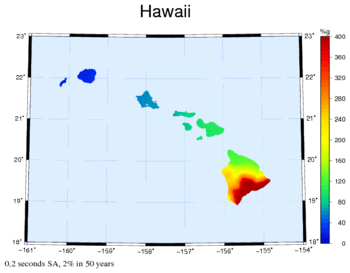Spectral acceleration
Spectral acceleration (SA) is a unit measured in g (the acceleration due to Earth's gravity, equivalent to g-force) that describes the maximum acceleration in an earthquake on an object – specifically a damped, harmonic oscillator moving in one physical dimension. This can be measured at (or specified for) different oscillation frequencies and with different degrees of damping, although 5% damping is commonly applied.[1] The SA at different frequencies may be plotted to form a response spectrum.

Spectral acceleration, with a value related to the natural frequency of vibration of the building, is used in earthquake engineering and gives a closer approximation to the motion of a building or other structure in an earthquake than the peak ground acceleration value,[1][2] although there is normally a correlation between [short period] SA and PGA.[2]
Some seismic hazard maps are also produced using spectral acceleration.
See also
- Seismic scale
External links
- Spectral Acceleration Hazard Map of California – for 1 sec period
- 2005 National Building Code of Canada – Spectral Acceleration Hazard Maps for various periods
- Revision of Time-Independent Probabilistic Seismic Hazard Maps for Alaska
- What is a ground shaking hazard map? – Includes explanations of SA and PGA
References
- Intensity Measure Type (IMT) OpenSHA, accessed 2011-04-14
- FAQs – What is "spectral acceleration" or SA? United States Geological Survey, accessed 2011-04-14